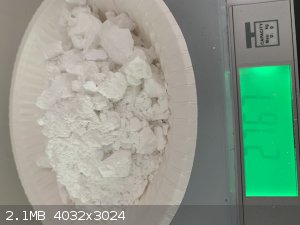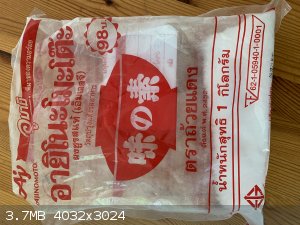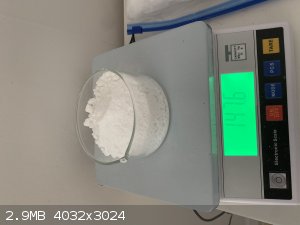DocX
Hazard to Others
  
Posts: 179
Registered: 22-10-2015
Member Is Offline
Mood: No Mood
|
|
Glutamic acid from MSG
Ok, just to check myself:
to obtain glutamic acid from store-bought MSG all I have to do is mix it with deionized water and then add HCl right? That should
1. Separate the glutamate and sodium ions in solution
2. Create NaCl
and the NaCl and the glutamate should be easy to separate through crystallization, in which the glutamate will crash out of solution well before the
NaCl?
Right?
Or is there a better way?
|
|
|
Texium
Administrator
       
Posts: 4667
Registered: 11-1-2014
Location: Salt Lake City
Member Is Offline
Mood: Preparing to defend myself (academically)
|
|
Not exactly. Being an amino acid, glutamic acid can be protonated at its amino group to become more water soluble in acidic conditions (it’s
amphoteric). So ideally you want to adjust the pH with HCl to be between the pKa of the amine group being protonated and the more acidic carboxylic
acid being deprotonated to insure minimal solubility. This pH range is approximately 2.1 to 4.0, so if you shoot for a pH of about 3, which can easily
be tested with universal indicator, you’ll probably be good. More acidic than that and you’ll start making the more water soluble cation. Less
acidic and you’ll still have glutamate anion.
|
|
|
DocX
Hazard to Others
  
Posts: 179
Registered: 22-10-2015
Member Is Offline
Mood: No Mood
|
|
Quote: Originally posted by Texium  | | Not exactly. Being an amino acid, glutamic acid can be protonated at its amino group to become more water soluble in acidic conditions (it’s
amphoteric). So ideally you want to adjust the pH with HCl to be between the pKa of the amine group being protonated and the more acidic carboxylic
acid being deprotonated to insure minimal solubility. This pH range is approximately 2.1 to 4.0, so if you shoot for a pH of about 3, which can easily
be tested with universal indicator, you’ll probably be good. More acidic than that and you’ll start making the more water soluble cation. Less
acidic and you’ll still have glutamate anion. |
Thank you for the excellent explanation!
But ... wasn't that exactly what I wrote? Just without all dem Fancy Big Words?
|
|
|
Syn the Sizer
National Hazard
   
Posts: 600
Registered: 12-11-2019
Location: Canada
Member Is Offline
|
|
Quote: Originally posted by DocX  |
Thank you for the excellent explanation!
But ... wasn't that exactly what I wrote? Just without all dem Fancy Big Words? |
Sort of.
If you acidify to within this range as Texium said pH 3 is probably best (that's where I aimed and it worked great) the amino acid will crash out in
the solution as it is, you can filter it, wash, recryst and you are good, if you drop below pH 2.1 you start to protonate the amino group as he
suggested. This would cause it to become more soluble in the acidic solution you are creating. Making recovery, well, honestly, I don't know.
So you are right that acidifying will free the acid, but you need to watch the pH or you will protonate the amino group.
Sorry for basically restating what Texium said but the key point was you must keep an eye on pH this is not a simple acid salt.
[Edited on 9-1-2022 by Syn the Sizer]
|
|
|
DocX
Hazard to Others
  
Posts: 179
Registered: 22-10-2015
Member Is Offline
Mood: No Mood
|
|
So in practical terms, I could, even without checking the pH, add HCl dropwise from say an addition funnel to a solution of MSG in water under
stirring, and see the pure glutamate precipitate out? Might actually be a good video to make.
|
|
|
mackolol
Hazard to Others
  
Posts: 459
Registered: 26-10-2017
Member Is Offline
Mood: Funky
|
|
By measuring the pH and making it between 2.1 and 4.0, you will get the best yield.
If you do it without checking the pH and just pouring HCl there until it starts precipitating your yields will likely get lower, because either SOME
of the glutamic acid will be remaining as soluble cation or anion, you can't see all of them just with your eye can you?
It would be a waste of reagents sort of. Is it that hard for you to get a pH paper?
|
|
|
Tsjerk
International Hazard
    
Posts: 3035
Registered: 20-4-2005
Location: Netherlands
Member Is Offline
Mood: Mood
|
|
Quote: Originally posted by DocX  | | So in practical terms, I could, even without checking the pH, add HCl dropwise from say an addition funnel to a solution of MSG in water under
stirring, and see the pure glutamate precipitate out? Might actually be a good video to make. |
Yes, participation is fast and obvious. But to see the end point by eye you would need liquid without precipitate, which would require so much water
the yield would suffer drastically. Glutamic acid is less soluble than the glutamate and the ammonium salt, but it is still quite soluble. You want
the glutamate and HCl as concentrated as you can get it. This will give a thick solution filling precipitation long before you add all HCl.
|
|
|
DocX
Hazard to Others
  
Posts: 179
Registered: 22-10-2015
Member Is Offline
Mood: No Mood
|
|
D'accord.
There is no real point in not measuring the pH, I was just thinking out loud. Probably, like I mentioned, a good instructional video to make:
doing the reaction in a three-necked rb, with an addition funnel and a digital pH meter in solution with the reading superimposed in the picture. I
love slomos of precipitations.
I use msg all the time in my cooking, it's the culinary anabolic steroid. I got bags of it. I've also been out of chemistry for a while and lately
been busy building my fume hood (among 1000 other things), so this will be a nice warm-up.
Thank you all!
|
|
|
papaya
National Hazard
   
Posts: 615
Registered: 4-4-2013
Member Is Offline
Mood: reactive
|
|
I'm sorry can I ask a short related question here? Thing is that I bought some MSG food suppliment but after searching information I got mixed
results about compound : some places state it as being monosodium glutamate while others say it is really the monohydrate salt. There's same
confusion even in scientific articles, I cannot figure out if both salts exist and if yes which one is a food additive, and also how to distinguish
one from the other. Being a high demand product I just cannot believe this thing is going unnotice - how could one buy a 1 tonn product considering
it can be +-10% crystalization water? Any thoughts ? I'm asking since there might be cases when you want to know exactly how many moles of reagent you
have to start with, while only using weights.
|
|
|
Tsjerk
International Hazard
    
Posts: 3035
Registered: 20-4-2005
Location: Netherlands
Member Is Offline
Mood: Mood
|
|
Quote: Originally posted by DocX  | D'accord.
There is no real point in not measuring the pH, I was just thinking out loud. Probably, like I mentioned, a good instructional video to make:
doing the reaction in a three-necked rb, with an addition funnel and a digital pH meter in solution with the reading superimposed in the picture. I
love slomos of precipitations.
I use msg all the time in my cooking, it's the culinary anabolic steroid. I got bags of it. I've also been out of chemistry for a while and lately
been busy building my fume hood (among 1000 other things), so this will be a nice warm-up.
Thank you all! |
Just do it in a beaker, makes getting the precipitate out so much easier.
I believe it's the monohydrate, but I was not able to figure it out by measuring pH after just adding HCl. To little weight variation and too much
uncertainty about the concentration of my HCl.
[Edited on 10-1-2022 by Tsjerk]
|
|
|
DocX
Hazard to Others
  
Posts: 179
Registered: 22-10-2015
Member Is Offline
Mood: No Mood
|
|
The experiment has been made.
1. An unweighed amount of store-bought MSG (yes yes, I know. I forgot, ok?) was dissolved in a 1 L beaker under vigorous stirring and gentle heating
in 800 ml of dH2O. Temp around 20 C. pH at start around 7.
2. From an addition funnel, conc HCl was added dropwise under vigorous stirring. White precipitates formed from every drop, but was quickly dissolved.
After about one minute, the solution turned milky white, and at pH 3.5 it was a thick slurry where magnetic stirring was no longer possible. Temp was
now 35 C, no external heating had been applied.
3. Solution was left to cool for 24 h. The slurry was then vacuum filtered, yielding a white paste with almost non-newtonian texture.
4. The paste was transferred to a pyrex dish and dried overnight in a hot air oven at 40 C, resulting in a chalk-like perfectly white powder, weight
276.7 g.
Pictures will be uploaded, but my connection is really bad right now.
So this is my L-glutamic acid. But how crude is it, and how about cleanup?
How do I recryst this? In heated, acidified (to about pH 3) H2O, harvesting the precipitates during cooling?
Any other purification steps that can be performed?
[Edited on 20222222/7/13 by DocX]
|
|
|
Tsjerk
International Hazard
    
Posts: 3035
Registered: 20-4-2005
Location: Netherlands
Member Is Offline
Mood: Mood
|
|
There is probably some NaCl, MSG and the HCl salt of glutamic acid present, but probably not too much. You could indeed recrystallize from water. You
don't have to add acid again as the glutamic acid is already protonated, you would only form more of the HCl salt if you would.
[Edited on 13-7-2022 by Tsjerk]
|
|
|
PirateDocBrown
National Hazard
   
Posts: 570
Registered: 27-11-2016
Location: Minnesota
Member Is Offline
Mood: No Mood
|
|
Yes, definitely recrystallize, add a minimum amount of boiling water to dissolve clear, then allow to cool, below 10C. Refilter, and rinse with ice
cold water.
Glutamic acid would be great for all sort of redox experiments and good lab practice.
Phlogiston manufacturer/supplier.
For all your phlogiston needs.
|
|
|
DocX
Hazard to Others
  
Posts: 179
Registered: 22-10-2015
Member Is Offline
Mood: No Mood
|
|
Thank you! Recryst it is.
And here's the pictures, finally have some web.
1. Crude product before recrystallisation.
2. Starting material
 
[Edited on 20222222/7/13 by DocX]
|
|
|
DocX
Hazard to Others
  
Posts: 179
Registered: 22-10-2015
Member Is Offline
Mood: No Mood
|
|
And, just to finish the thread:
1. 276.7 g of crude product was dissolved with some difficulty in about 1 L of boiling dH2O. The solution seemed saturated.
2. It was left in room temperature overnight, with a beautiful snowfall of crystals forming almost directly.
3. Finally, it was put in the freezer until ice crystals started forming on the surface. The solution was then vacuum filtered and the cloudy water
discarded.
Final yield of crispy white glutamic acid 147.6 g. A significant loss in the recrystallisation, to say the least. But the final product has a very
different texture compared to the crude product, which had a very chalky texture. When I was grinding it up it jammed up my grinder. The final product
is much more of a crispy, crystalline salt.
I’m happy anyway, this is more than I need and it didn’t cost me much: like a euro for the MSG and maybe 2 for the dH2O.
Thanks for all the feedback and tips! I’m onward to a pyridine synth.
|
|
|
PirateDocBrown
National Hazard
   
Posts: 570
Registered: 27-11-2016
Location: Minnesota
Member Is Offline
Mood: No Mood
|
|
Next time, don't discard the mother liquor. Instead, boil it down to about half volume, then chill it again, to gather a second crop of crystals.
Phlogiston manufacturer/supplier.
For all your phlogiston needs.
|
|
|
Fantasma4500
International Hazard
    
Posts: 1682
Registered: 12-12-2012
Location: Dysrope (aka europe)
Member Is Offline
Mood: dangerously practical
|
|
interesting, glutamine can be made from glutamic acid and ammonia
this maaay be decarboxylated into pentylamine .. 5 carbons right?
now that would be a rather OTC amine, oxidation into nitropentane
|
|
|
DocX
Hazard to Others
  
Posts: 179
Registered: 22-10-2015
Member Is Offline
Mood: No Mood
|
|
And the picture
I’ve been doing my chemistry in very sparse conditions on the countryside, literally in a wood shed. And no internet to speak of. So uploading
pictures has been difficult.
Now, however, I’m back in the concrete jungle. Here’s the obligatory picture of the final salt.
I wish I could add detailed pictures of the crude salt vs the final product, but I didn’t save any of the crude product.
The texture really is quite different. The crude salt was really chalky. I wonder if it was due to the NaCl or the glutamic HCl contamination.
Probably the latter. NaCl is not chalk- like after all.

[Edited on 20222222/7/19 by DocX]
[Edited on 20222222/7/19 by DocX]
|
|
|
Texium
Administrator
       
Posts: 4667
Registered: 11-1-2014
Location: Salt Lake City
Member Is Offline
Mood: Preparing to defend myself (academically)
|
|
Quote: Originally posted by Antiswat  | interesting, glutamine can be made from glutamic acid and ammonia
this maaay be decarboxylated into pentylamine .. 5 carbons right?
now that would be a rather OTC amine, oxidation into nitropentane |
Umm no? Glutamine contains 5 carbons, so
you’d end up with a 4-carbon molecule if you did decarboxylate it. Specifically, you’d end up with the amide form of GABA.
|
|
|